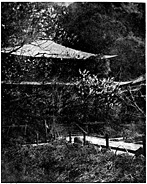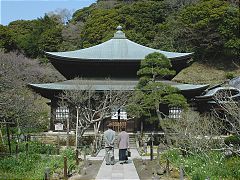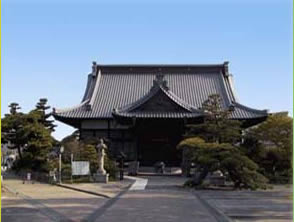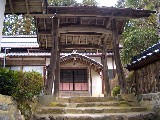Zuisenji
Historical Overview
The Temple was erected at the end of the Kamakura Period (1185-1333) by Do-un
Nikaido (1267-1334), a high-ranking and intelligent military commander of the
Kamakura Shogunate, naming Priest Muso (1275-1351) as the founding priest.
 Entering the Muromachi Period (1336-1573), the Temple continued to
receive patronage from the Ashikaga family, who controlled the Muromachi
Shogunate. In fact, the Temple once had a sub-temple for mother of Takauji
Ashikaga (1305-1358), the founder of Muromachi Shogunate. The Temple was so
closely associated with the family that remains of four Kamakura Governors and
other members of the Ashikaga family were buried here.
Entering the Muromachi Period (1336-1573), the Temple continued to
receive patronage from the Ashikaga family, who controlled the Muromachi
Shogunate. In fact, the Temple once had a sub-temple for mother of Takauji
Ashikaga (1305-1358), the founder of Muromachi Shogunate. The Temple was so
closely associated with the family that remains of four Kamakura Governors and
other members of the Ashikaga family were buried here.
Founding priest Soseki Muso was born in Ise, Mie Prefecture. As a Zen priest,
he came to Kamakura in 1295 at age 20. After studying Zen further in Kyoto, he
came back to Kamakura in 1299 at the invitation of Takatoki Hojo (1303-1333),
the 14th Regent, and joined Kenchoji. In 1327, he was enrolled in Jochiji, while
helping Nikaido to found the Temple. Engakuji nominated him to be
its 15th chief priest. Obai-in sub-temple in Engakuji was built solely for him,
where he educated quite a few young priests, and later they were called
Muso-school priests. So influential they were that it was no exaggeration to say
their dogma was the mainstream of Zen Buddhism in the Muromachi Period.
In addition to Zen, Priest Muso also had an excellent talent as a garden
designer. Famous gardens designed by him include those of Saihoji, a.k.a. the
Moss Temple, and Tenryuji in Kyoto. Most notable among the temples he founded
would probably be the world-famous Ryoanji and Rokuonji, generally known as
Kinkakuji (Gold Pavilion) in Kyoto.
One of Priest Muso's disciple was a priest by the name of Shusin Gido
(1325-1388), who once lived in the Temple, though mostly active in Kyoto serving
Yoshimitsu Ashikaga (1358-1408), the Third Ashikaga Shogun, as a Zen master.
When Yoshimitsu and Ujimitsu Ashikaga (1359-1398), the Second Kamakura Governor,
was on the verge of crash, the Priest Gishu stepped in as a mediator and settled
the dispute amicably.
In its golden days, the Temple had more than 10 sub-temples. In the late
Muromachi Period, however, the Temple's fortune began to wane with no specific
patrons or sponsors. Engakuji helped the Temple in the Edo Period (1603-1868)
sending chief priests from time to time. Mitsukuni Tokugawa (1628-1700), one of
the most powerful and well-known members of the Tokugawa family, often came to
Kamakura, and donated a wooden statue of Senju (One-Thousand Armed)
Kan'non, or Sahasrabhuja in Skt, which is now enshrined in the main
hall.
Main Hall
 It is a typical Zen style structure called Hogyo zukuri with its
roofs curved upward and rafters spread radially. On top of the roof is a
peach-shaped Hoju, or mani in Skt. A similar structure is also seen at
the main hall of Tokeiji.
It is a typical Zen style structure called Hogyo zukuri with its
roofs curved upward and rafters spread radially. On top of the roof is a
peach-shaped Hoju, or mani in Skt. A similar structure is also seen at
the main hall of Tokeiji.
Enshrined in the center as the main object of worship is a statue of Shaka
Nyorai (Sakyamuni in Sanskrit), and that of Senju Kan'non on his
right. Also enshrined to the left of the Shaka statue is that of Priest
Muso. All are rather small, perhaps less than 1 meter tall.
Senju Kan'non is listed as the sixth of the Kamakura Thirty-Three
Kan'non Pilgrimage.
Kaisando Hall
A small structure standing on the left of the main hall is Kaisando ,
or the hall for the founding priest. It is a repository for the valuable assets
and the following statues are housed:
- A 120-centimeter-tall wooden, sedentary statue of Priest Muso, the
founding priest, carved in the 14 century shortly after his death. It is
highly esteemed by connoisseurs and the artistic value is said to be
comparable to that of Priest Mugaku at Engakuji.
- A wooden statue of Motouji Ashikaga (1340-1367), the first Kamakura
Governor who died young at the age of 27, and that of Ujimitsu Ashikaga
(1359-98), the second Kamakura Governor. Both statues were made during the Edo
Period (1603-1868).
Dokomoku Jizo
 Next to the Kaisando Hall stands a small hall, in which a statue
of Jizo Bosatsu, or Ksitigarbha-bodhisattva in Skt. is enshrined. It was
fashioned during the latter half of the Kamakura Period (1185-1333), and
installed at another Zen temple called Chiganji (no longer exists) located at
Ogigayastu, northwestern part of Kamakura. When Chiganji was financially drained
to the extent of dilapidation, a caretakers of the statue tried to run away. But
a Jizo Bosatsu appeared in his dream one night and told him, "No matter
where you may go, there would be no change." Following the divine suggestion,
the caretaker stayed at the temple and continued to take care of the statue all
the rest of his life. This is a story told probably in the Edo Period. Without
any financial support from parishioners or other institutions, many temples had
to make ends meet selling temple assets such as Buddha statues and bells, and
some of them were forced to just disappear. Dokomo means everywhere
implying the condition will remain unchanged no matter where you may choose to
go.
Next to the Kaisando Hall stands a small hall, in which a statue
of Jizo Bosatsu, or Ksitigarbha-bodhisattva in Skt. is enshrined. It was
fashioned during the latter half of the Kamakura Period (1185-1333), and
installed at another Zen temple called Chiganji (no longer exists) located at
Ogigayastu, northwestern part of Kamakura. When Chiganji was financially drained
to the extent of dilapidation, a caretakers of the statue tried to run away. But
a Jizo Bosatsu appeared in his dream one night and told him, "No matter
where you may go, there would be no change." Following the divine suggestion,
the caretaker stayed at the temple and continued to take care of the statue all
the rest of his life. This is a story told probably in the Edo Period. Without
any financial support from parishioners or other institutions, many temples had
to make ends meet selling temple assets such as Buddha statues and bells, and
some of them were forced to just disappear. Dokomo means everywhere
implying the condition will remain unchanged no matter where you may choose to
go.
Stone Monument for Sho-in Yoshida
 Near the Temple gate stands a stone monument for Sho-in
Yoshida (1830-1859), one of the most influential patriot in the mid 19th
century. Back at the time, Japan was under tremendous pressure from Western
powers to open up the country to the world. Priest Sho-in Chiku-in (1796-1867),
the 25th chief priest of the Temple, was his uncle and Yoshida visited here once
in a while to see him. When Commodore Matthew C. Perry (1794-1858) of the U.S.
Navy came again near the shore of the Miura Peninsula in March 1854, Yoshida
slipped aboard one of the Commodore's ships in an attempt to smuggle himself to
the West. The night before the attempt, he had visited the Temple and met with
the uncle. His plan, however, turned out unsuccessful and he was imprisoned.
Later, he was executed in Tokyo at the age of 28.
Near the Temple gate stands a stone monument for Sho-in
Yoshida (1830-1859), one of the most influential patriot in the mid 19th
century. Back at the time, Japan was under tremendous pressure from Western
powers to open up the country to the world. Priest Sho-in Chiku-in (1796-1867),
the 25th chief priest of the Temple, was his uncle and Yoshida visited here once
in a while to see him. When Commodore Matthew C. Perry (1794-1858) of the U.S.
Navy came again near the shore of the Miura Peninsula in March 1854, Yoshida
slipped aboard one of the Commodore's ships in an attempt to smuggle himself to
the West. The night before the attempt, he had visited the Temple and met with
the uncle. His plan, however, turned out unsuccessful and he was imprisoned.
Later, he was executed in Tokyo at the age of 28.
Buddhism
 Entering the Muromachi Period (1336-1573), the Temple continued to
receive patronage from the Ashikaga family, who controlled the Muromachi
Shogunate. In fact, the Temple once had a sub-temple for mother of Takauji
Ashikaga (1305-1358), the founder of Muromachi Shogunate. The Temple was so
closely associated with the family that remains of four Kamakura Governors and
other members of the Ashikaga family were buried here.
Entering the Muromachi Period (1336-1573), the Temple continued to
receive patronage from the Ashikaga family, who controlled the Muromachi
Shogunate. In fact, the Temple once had a sub-temple for mother of Takauji
Ashikaga (1305-1358), the founder of Muromachi Shogunate. The Temple was so
closely associated with the family that remains of four Kamakura Governors and
other members of the Ashikaga family were buried here. It is a typical Zen style structure called Hogyo zukuri with its
roofs curved upward and rafters spread radially. On top of the roof is a
peach-shaped Hoju, or mani in Skt. A similar structure is also seen at
the main hall of Tokeiji.
It is a typical Zen style structure called Hogyo zukuri with its
roofs curved upward and rafters spread radially. On top of the roof is a
peach-shaped Hoju, or mani in Skt. A similar structure is also seen at
the main hall of Tokeiji. Next to the Kaisando Hall stands a small hall, in which a statue
of Jizo Bosatsu, or Ksitigarbha-bodhisattva in Skt. is enshrined. It was
fashioned during the latter half of the Kamakura Period (1185-1333), and
installed at another Zen temple called Chiganji (no longer exists) located at
Ogigayastu, northwestern part of Kamakura. When Chiganji was financially drained
to the extent of dilapidation, a caretakers of the statue tried to run away. But
a Jizo Bosatsu appeared in his dream one night and told him, "No matter
where you may go, there would be no change." Following the divine suggestion,
the caretaker stayed at the temple and continued to take care of the statue all
the rest of his life. This is a story told probably in the Edo Period. Without
any financial support from parishioners or other institutions, many temples had
to make ends meet selling temple assets such as Buddha statues and bells, and
some of them were forced to just disappear. Dokomo means everywhere
implying the condition will remain unchanged no matter where you may choose to
go.
Next to the Kaisando Hall stands a small hall, in which a statue
of Jizo Bosatsu, or Ksitigarbha-bodhisattva in Skt. is enshrined. It was
fashioned during the latter half of the Kamakura Period (1185-1333), and
installed at another Zen temple called Chiganji (no longer exists) located at
Ogigayastu, northwestern part of Kamakura. When Chiganji was financially drained
to the extent of dilapidation, a caretakers of the statue tried to run away. But
a Jizo Bosatsu appeared in his dream one night and told him, "No matter
where you may go, there would be no change." Following the divine suggestion,
the caretaker stayed at the temple and continued to take care of the statue all
the rest of his life. This is a story told probably in the Edo Period. Without
any financial support from parishioners or other institutions, many temples had
to make ends meet selling temple assets such as Buddha statues and bells, and
some of them were forced to just disappear. Dokomo means everywhere
implying the condition will remain unchanged no matter where you may choose to
go. Near the Temple gate stands a stone monument for Sho-in
Yoshida (1830-1859), one of the most influential patriot in the mid 19th
century. Back at the time, Japan was under tremendous pressure from Western
powers to open up the country to the world. Priest Sho-in Chiku-in (1796-1867),
the 25th chief priest of the Temple, was his uncle and Yoshida visited here once
in a while to see him. When Commodore Matthew C. Perry (1794-1858) of the U.S.
Navy came again near the shore of the Miura Peninsula in March 1854, Yoshida
slipped aboard one of the Commodore's ships in an attempt to smuggle himself to
the West. The night before the attempt, he had visited the Temple and met with
the uncle. His plan, however, turned out unsuccessful and he was imprisoned.
Later, he was executed in Tokyo at the age of 28.
Near the Temple gate stands a stone monument for Sho-in
Yoshida (1830-1859), one of the most influential patriot in the mid 19th
century. Back at the time, Japan was under tremendous pressure from Western
powers to open up the country to the world. Priest Sho-in Chiku-in (1796-1867),
the 25th chief priest of the Temple, was his uncle and Yoshida visited here once
in a while to see him. When Commodore Matthew C. Perry (1794-1858) of the U.S.
Navy came again near the shore of the Miura Peninsula in March 1854, Yoshida
slipped aboard one of the Commodore's ships in an attempt to smuggle himself to
the West. The night before the attempt, he had visited the Temple and met with
the uncle. His plan, however, turned out unsuccessful and he was imprisoned.
Later, he was executed in Tokyo at the age of 28.